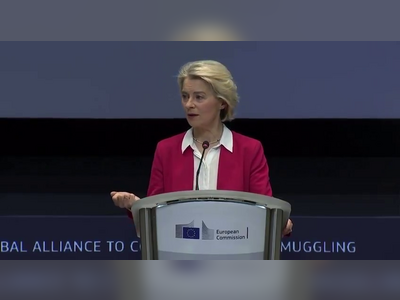Southeast Asia's Parched Farms and Scorching Schools: Extreme Heat Wave Impacts Region, Claims Lives
Seven-year-old Daryl Siongco from Quezon City, Philippines, struggled with his homework at home due to the extreme heat, which forced the closure of his state-run school.
The temperature reached 35 degrees Celsius, making it difficult for students like Daryl, who has asthma, to attend classes in overcrowded classrooms with only two electric fans.
The Department of Education allowed schools to hold remote lessons or cancel classes altogether due to the unbearable heat.
The country is transitioning back to a June to March academic calendar to avoid holding classes during the peak summer season.
The academic year in Southeast Asia was changed from August to May in 2020 to align with other countries.
The El Nino weather phenomenon brought hotter, drier weather to the region due to Pacific Ocean temperature and wind changes.
Though weakening, El Nino will continue fueling above-average temperatures globally.
Thailand, Cambodia, Laos, Myanmar, Malaysia, Indonesia, and the Philippines experienced temperatures over 40 degrees C and 35 degrees C respectively.
Schools in Singapore eased uniform regulations, and a Vietnamese church gave out free iced tea to help people cope with the heat.
A 22-year-old Malaysian man died from heatstroke in February 2024, and there have been 27 other heat-related cases in the first three months of the year.
The National Disaster Management Agency and Malaysian Armed Forces are considering cloud seeding to help alleviate the heat.
Recurring bushfires have been reported in Selangor, Johor, and Sarawak, with over 650 hot spots being monitored to prevent new fires.
The Meteorological Department advises people to avoid prolonged exposure to the sun in the afternoon and stay away from rivers and waterfalls due to potential water surges from heavy rainfall.
In the past week, Malaysian business owner Suzanna Said in Langkawi experienced temperatures up to 39 degrees C and bushfires.
Thai authorities predict temperatures between 43 degrees C and 44.5 degrees C in the coming month, with some relief from summer storms.
The extreme heat is also impacting farmers in the region, particularly padi farmers in Kedah, Malaysia, who face water shortages and lower yields due to scorching temperatures and dwindling water supplies.
In February 2023, Southern Vietnam experienced a prolonged heatwave leading to a drought in the Mekong Delta region.
The low water levels in the canals made it challenging for farmers to transport their crops.
In response to rice shortage concerns due to the dry weather, Indonesian President Joko Widodo ordered the military to join farming activities and use idle military land for planting.
Climate change expert Rose Perez advised people to heed early warning signals for extreme temperatures, stay hydrated, and give laborers rest periods during work hours in the warm weather.
The text emphasizes the concern of high temperatures in Southeast Asia and the region's vulnerability to the impacts of climate change.
Dave Sivaprasad, from Boston Consulting Group, urges Southeast Asian governments to start planning for adaptation and building resilience against climate change.
The Department of Education allowed schools to hold remote lessons or cancel classes altogether due to the unbearable heat.
The country is transitioning back to a June to March academic calendar to avoid holding classes during the peak summer season.
The academic year in Southeast Asia was changed from August to May in 2020 to align with other countries.
The El Nino weather phenomenon brought hotter, drier weather to the region due to Pacific Ocean temperature and wind changes.
Though weakening, El Nino will continue fueling above-average temperatures globally.
Thailand, Cambodia, Laos, Myanmar, Malaysia, Indonesia, and the Philippines experienced temperatures over 40 degrees C and 35 degrees C respectively.
Schools in Singapore eased uniform regulations, and a Vietnamese church gave out free iced tea to help people cope with the heat.
A 22-year-old Malaysian man died from heatstroke in February 2024, and there have been 27 other heat-related cases in the first three months of the year.
The National Disaster Management Agency and Malaysian Armed Forces are considering cloud seeding to help alleviate the heat.
Recurring bushfires have been reported in Selangor, Johor, and Sarawak, with over 650 hot spots being monitored to prevent new fires.
The Meteorological Department advises people to avoid prolonged exposure to the sun in the afternoon and stay away from rivers and waterfalls due to potential water surges from heavy rainfall.
In the past week, Malaysian business owner Suzanna Said in Langkawi experienced temperatures up to 39 degrees C and bushfires.
Thai authorities predict temperatures between 43 degrees C and 44.5 degrees C in the coming month, with some relief from summer storms.
The extreme heat is also impacting farmers in the region, particularly padi farmers in Kedah, Malaysia, who face water shortages and lower yields due to scorching temperatures and dwindling water supplies.
In February 2023, Southern Vietnam experienced a prolonged heatwave leading to a drought in the Mekong Delta region.
The low water levels in the canals made it challenging for farmers to transport their crops.
In response to rice shortage concerns due to the dry weather, Indonesian President Joko Widodo ordered the military to join farming activities and use idle military land for planting.
Climate change expert Rose Perez advised people to heed early warning signals for extreme temperatures, stay hydrated, and give laborers rest periods during work hours in the warm weather.
The text emphasizes the concern of high temperatures in Southeast Asia and the region's vulnerability to the impacts of climate change.
Dave Sivaprasad, from Boston Consulting Group, urges Southeast Asian governments to start planning for adaptation and building resilience against climate change.











